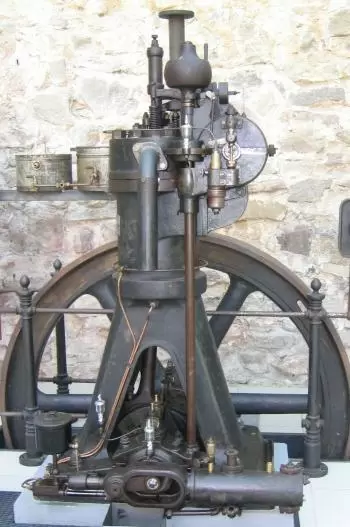
The diesel engine is an alternative internal combustion engine that was purported to be an alternative to steam engines. The main difference with a gasoline engine is that it generates the ignition of the fuel due to the high temperatures derived from the high pressure to which the fuel is subjected.
However, before reaching the diesel engine, numerous thermal engine prototypes were designed.
At the beginning of the 19th century, the brothers Claude and Nicéphore Niépce developed the first known internal combustion engine and the first direct fuel injection system. In 1816 they experimented with alcohol and white petroleum oil (similar to kerosene). They discovered that kerosene-type fuel could be vaporized. By being vaporized, it made the fuel highly flammable.
Brayton's constant pressure engine
In 1874, George Brayton developed and patented a 2-stroke oil-fired constant pressure engine, "The Ready Motor." This engine used a metering pump to supply fuel to an injection device in which oil was vaporized by air and burned as it entered the cylinder. Brayton motors were used to supply mechanical power.
Between 1887 and 1890 Brayton developed and patented two 4-stroke oil engines. Brayton died in 1893, but he was credited with inventing the constant pressure Brayton cycle.
Hot bulb motors
The hot bulb engine is the predecessor of the diesel engine. The first built models of this type of engine were produced starting in 1891 by Richard Hornsby and Sons. In this type of engine they used a low pressure fuel injection system.
The Hornsby-Akroyd oil engine used a comparatively low compression ratio, so the temperature of the compressed air was not high enough to initiate combustion.
Instead, the combustion took place in a separate combustion chamber, the "vaporizer" or "hot bulb" mounted on the cylinder head, into which the fuel was sprayed. Autoignition was caused by contact between the air-fuel mixture and the hot walls of the vaporizer.
In 1892, Akroyd Stuart patented a water-jacketed vaporizer to increase compression ratios. The main objective was to reduce autoignition problems at higher loads and compression ratios.
Who Invented the Diesel Engine?
The diesel engine was invented by Rudolf Diesel in 1893. Rudolf Diese was a German engineer, employed by the MAN firm.
Rudolf Diesel studied high thermal performance engines, with the use of alternative fuels in internal combustion engines. Diesel's goal was to replace old steam engines that were inefficient, very heavy, and expensive.
In 1892 he proposed the first theoretical cycle of the diesel engine, while the first real model was built in 1897.
The original cycle proposed by Rudolf Diesel in 1892 was a constant temperature cycle. Diesel's idea was to compress the air so hard that the air temperature exceeded that of combustion.
Using the diesel engine
In later years, Diesel realized that its original cycle would not work and adopted the constant pressure cycle. Diesel, in the corresponding patent description, no longer mentions that compression temperatures must exceed combustion temperature. Now all that is mentioned is that the compression must be high enough for ignition.
For years Diesel worked to be able to use fuels other than gasoline derived from petroleum. The fuel used was light oil known as fuel oil.
In 1897, MAN produced the first engine according to studies by Rudolf Diesel. The first diesel engines were made for ships and transport vehicles.
In the 1930s, Mercedes-Benz launched the first diesel-powered passenger car on the market.